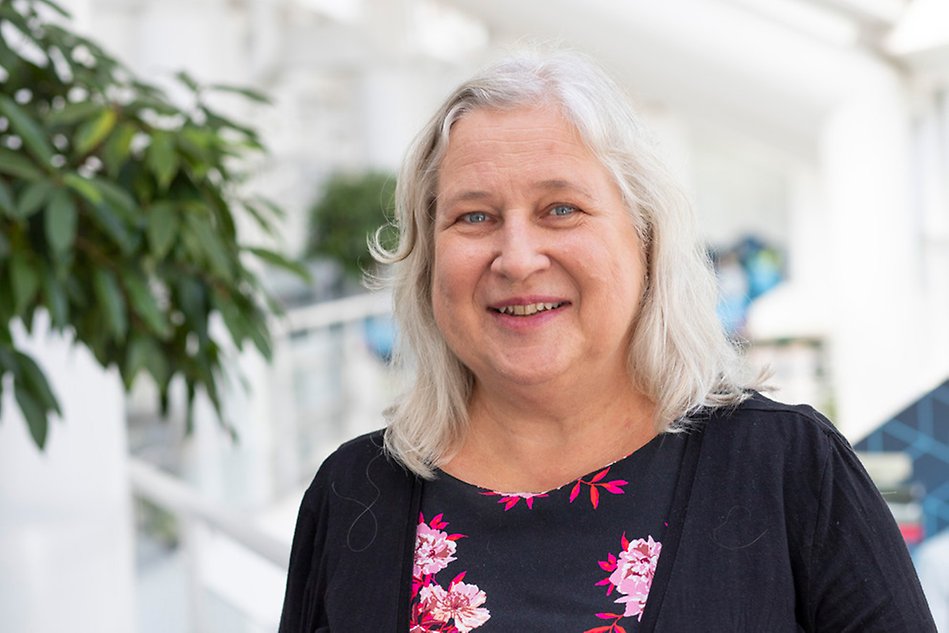The amazing journey of the subject of informatics at Halmstad University
The first time I came into contact with the subject of informatics was in 1987. At that time, I was a student at the computer economics program at Halmstad University. Back then, the subject was called ADP – Administrative Data Processing, or sometimes Automatic Data Processing. After ID checks and signatures to follow the rules, we were allowed into the University's computer room from time to time.
This is a personally written text. Any opinions expressed are the author’s own.
“My hope is that informatics will continue to contribute to good development and high quality for Halmstad University, and I hope that our journey can inspire other subjects and areas that have the ambition to develop."
Maria Åkesson, Professor

This year Halmstad University celebrates its 40th anniversary! In a series of chronicles, you get to follow Halmstad University's 40-year research journey, from no research to research for innovation. In this chronicle, you will get insights into how the subject of informatics has evolved at the University, from the perspective of Professor Maria Åkesson.
There were no hard drives, no internet, and no printers. The software was loaded from a 5 1/4 inch floppy disk, and if we wanted to save something, we had to do it on our own expensive floppy disk. We were taught about punch cards, the design of the computer, operating systems, commands, number system conversion and assembly language programming. I understand that this this might be all Greek to many people today, even to our informatics students.
What I want to illustrate is that the subject of informatics is evolving in step with digital technology. The subject is constantly changing and evolving, which requires a high degree of flexibility in the design of education and research. At Halmstad University, the subject of informatics has its roots in ADP in the 1980s. Since then, it has developed into a subject with education at all levels, and into a strong research area with a focus on digital service innovation. This means that we study how digital technology and digitisation can contribute to improvement and renewal. But what was the journey to get here?
Stage 1 – from supporting subject to Bachelor’s Programme in Informatics
During the first stage of the subject’s development, informatics was a supporting subject for education in business administration. There was no research tied to the subject, but a lot of pressure to train students in computer technology. IT was the big trend – it was the future. Local networks, the internet, e-mail, and e-commerce were trends that led to the creation of the dot-com bubble in the 1990s. The trends meant that the nature of the subject shifted from system design to design of IT use, and subsequently, the subject changed its name. In most universities, it is now referred to as informatics, at some it is referred to as systems science or information systems. In any case, no higher education institution has retained the subject designation ADB.

Maria Åkesson. Photo: Dan Bergmark
At Halmstad University, we started the IT Economics Programme in 1995, where a third of the courses were within the subject of informatics. The programme became a strong brand and nationally known. In 1999, the first bachelor's programme in informatics was started. The programme played an important role in meeting the development of society and the labour market's need for system developers and IT designers. This meant that the subject of informatics was established as a bachelor’s subject, an important milestone for the subject and resulting in us being able to recruit teachers and an interest in research emerging. At that time, we only had one teacher with a PhD in informatics, but several had started doctoral studies at other universities.
Stage 2 – from undergraduate to research subject
In 2000, a reorganisation was carried out at the University, which meant that the subject of informatics was co-organised with other IT-related education and research. This was an important shift in the development of informatics. Previously, education and research were separated organisationally, and now they were co-organised. We were encouraged to start research, apply for external funding and to publish scholarly. Research-qualified staff and a visiting professor were recruited.
2004 was an important year on our journey. The informatics programmes were then evaluated by the The Swedish National Agency for Higher Education (today and passed on all points. It was also this year that we managed to get external research funding for the first time. The EU project DigiNews was the start of informatics research at Halmstad University and our first research group, Media-IT, was formed under the leadership of Professor Carina Ihlström Eriksson. This was followed by several projects in collaboration with the newspaper industry and led to us being able to publish our research, fund doctoral education and strengthen the academic merits of the informatics group.
Then came the burst of the the dot-com bubble, and students’ interest in IT education plummeted. The economy suffered and we had to cut back on educational activities. During this downturn, we initiated new programmes with relevance to the labour market, which we hoped would attract students. The Edutainment Software Design programme was started, and the IT Economics programme was reworked into the ERP programme. The number of students increased again, and when we were re-evaluated by the The Swedish National Agency for Higher Education in 2011, we were the only Swedish university to be assessed as very high quality for our bachelor's programme in informatics. Hallandsposten’s headline on 13 June 2012 read “Very high quality in informatics education”. It was gratifying and an acknowledgment that our high ambition and our quality work had yielded results. “Informatics in Halmstad” became a concept in the Swedish informatics contexts and was associated with seriousness and ambition.

Stage 3 – from education and research environment to complete academic environment
In 2013, the University's research environments were evaluated, which provided guidance for continued development. As part of the evaluation, a self-evaluation was carried out, which included formulating a profile for the research in informatics. We then formulated the profile Digital Service Innovation. As a result, one of the bachelor's programmes was reworked into Digital Innovation and Design. The informatics profile celebrates its tenth anniversary this year.
The next milestone was in 2015 when informatics became a third-cycle subject. This means that we can award doctoral degrees at the University. In 2018, we also started an international master's programme with the same profile. Through this profiling, we have been able to clearly integrate education, research, and collaboration. We have attracted new employees and recruited complementary skills, including cognitive science and design ethnography. Today, we have an international environment where doctoral students, post-docs and assistant professors can contribute to research and gain merit. We also have a teaching staff with great commitment and high ambitions for the quality of informatics education. We are three professors, two of whom being the only professors who are women at the School of Information Technology. We participate in two of the University's research programmes, LeaDS and REBEL, and have two new master's programmes under development. In other words, we are in an expanding phase of our journey, which can sometimes bring some growing pains.
How has this journey been possible?
Of course, the ride has been bumpy at times, but it has been worth the effort and we have reached our goals. It has been made possible through committed enthusiasts, academisation and quality awareness, academic entrepreneurship, collegial collaboration, a certain amount of enthusiasm – and because we have had fun! The informatics group, or MI-lab as we were once called, has become known within the University for its collaborative culture. We have used good advice, taken support from the organisation when we have been able to get it, and built a strong network, both within the subject and with the surrounding community. But the most important thing is that we have built relevant, attractive, and high-quality education. Without students, we don’t have a subject. Our biggest footprint in society is our students who we educate and who enter working life. That is why we are particularly proud of the positive reviews that our students receive from employers.
The future of informatics at Halmstad University
When I am asked why I want to work as a professor of informatics at Halmstad University, I answer that I have the best job in the world. It’s varied – each of my 30 years at the University has been unique, every year a new journey. The most exciting part of the journey lies ahead of us. The future of digitisation with robotisation, automation, AI – what will it bring? How can we design human-technology interaction so that it contributes to a better world? The subject of informatics has a very important role in researching these questions.
We are now facing a generational shift. Those of us who have been around for almost 40 years will not stay on the journey for another 40 years. My hope is that informatics will continue to contribute to good development and high quality for Halmstad University, and I hope that our journey can inspire other subjects and areas that have the ambition to develop.
Text: Maria Åkesson
Photo: iStock (unless otherwise stated)


